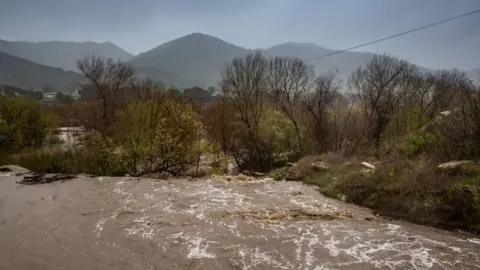Why California's storm is unlikely to reverse its drought
 Getty Images
Getty ImagesCalifornia - one of the driest states in the US - is being inundated with torrential rain and flooding.
And given the decades-long drought in the region, which has led to restrictions on water usage in some areas, you might be wondering if this extreme weather could in some ways be a positive.
But the downpour is unlikely to have a big impact on the drought.
In fact, experts say it would take consecutive years of severe wet weather to reverse it in the long-term.
California, along with other states in the western US, is suffering from a long drought that has dried up its wells and drained its water reservoirs. In 2022, the state experienced its third year of severe drought and the driest on record.
Yet less than a year later, it is seeing its wettest ever two-week period.
The weather has proven dangerous and deadly, but it has also brought a small reprieve to the severe drought conditions. According to the US Drought Monitor, areas under severe to extreme drought have slightly shrunk.
The storm also appears to have lifted 7% of California out of exceptional drought conditions, the drought monitor shows.
Despite this, experts say California will need a lot more water to reverse its drought conditions as the state has to catch up with the little rainfall it has seen over the last few years.
"It's going to take many methods and several wet years to make up for the region's long period of low rainfall," wrote Andrew Fisher, a professor of Earth and Planetary Sciences at the University of California, Santa Cruz, in The Conversation.
"One storm certainly doesn't do it, and even one wet year doesn't do it."
Jay Lund, a professor of civil and environmental engineering at the University of California, Davis, said the current storm has been good in replenishing some of the state's water supply. "It's always good to see rain in California," he told the BBC.
But he added that California's weather is that of extremes, and more years of dry weather are likely to come.
Another issue experts have raised is the limited reservoir capacity. Prof Fisher wrote that while some can store large volumes of water, others that are near capacity have to release some water to make room for the next storm.
"Unless there's another reservoir downstream, a lot of that water is going out to the ocean," he said.
In larger cities, flood water is of no use as it is often contaminated, he added, making it tough to store and unsuitable for drinking.
To avoid a large portion of storm water going to waste, some scientists have suggested making room for water to flood safely into surrounding areas as opposed to relying on levees that mitigate where river water goes.
This would also help store more water underground, which can then be used in drier summers. The catch, however, is that these excess floods would force some people to relocate from their homes.
This process would also require a significant rebuild of existing infrastructure and a relocation plan for impacted communities. So it would have little effect in the short-term.
"If this is the last rainstorm of this season, a month from now we could be in trouble again," Mr Fisher said.
